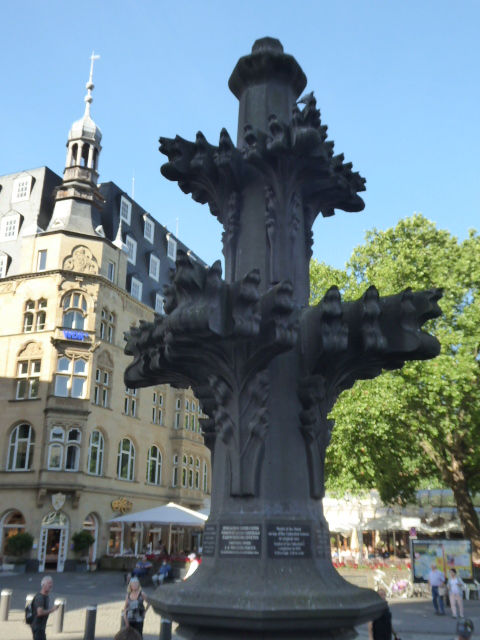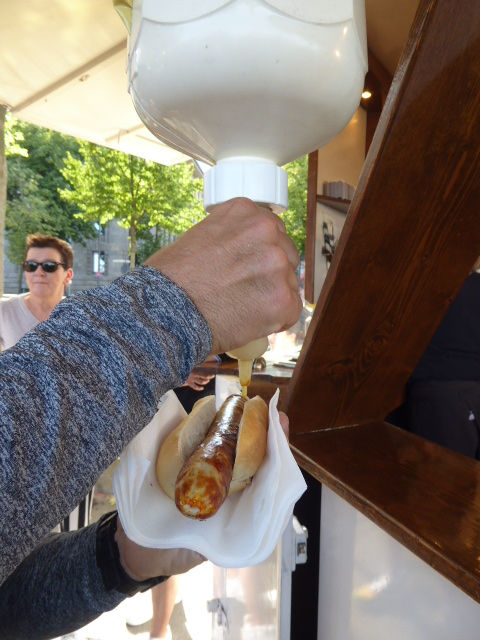Our Day in Cologne
- TravelingFoodie2
- Jan 15, 2023
- 4 min read
We arrived in Zons at 9 am, 26 km north of Cologne (Koln in German). We got off the ship and boarded buses for the 25-minute drive to Cologne. Otherwise, it would have taken 3 hours to travel by ship. This gave us a little more time to spend in Cologne.

Cologne is Germany's 4th largest city. It was established as a city by the Roman Emperor Claudius as a gift to his wife Agrippina.
The bus dropped us off on Gereonstrasse, near the Memorial to Edith Stein, a statue with 3 images of her and a pile of shoes. She was born Jewish, converted to Catholicism but was deported to Auschwitz during WWII. She was killed on August 9, 1942, 2 days after arriving. In 1987, Pope John Paul II beatified her as a martyr, and in 1998 he canonized her as a saint. Our guide did not mention the statue and I learned about the story much later. I wish I could have spent more time examining it. Here's some more information by the everydayhistorian:
https://everydayhistorian.wordpress.com/2015/03/23/history-on-the-street-postwar-memorials-in-cologne/

The Koln Dom (Cologne Cathedral) is Germany's largest Gothic cathedral. During WWII, over 95% of Cologne was destroyed. The Dom was spared because it was so massive that it was used as a navigational aid by the bombers.

At the entrance to the cathedral is a replica of a spire tip. The real thing is 515 feet above.

The entrance to the Dom is ornate.

The Roman Arch or North Gate of the Roman City (from AD 50) was discovered nearby and set up near the Cathedral, as a reminder of the city's Roman roots.

Inside, you'll find 140-foot tall ceilings. The church was begun in 1248 but sat unfinished because funds dried up. In the early 1800s, with help from the Prussians, the church was finished in 38 years (1842-1880).


We didn't get to see the Shrine of the Magi which contains the skulls of the 3 Wise Men. The front end of the church, where the relics are kept, was closed.
At the rear of the church is a pieta.

Gargoyles outside the church are fanciful figures and animals.

Nearby is the Roman-Germanic Museum, Peek through the window to see a beautiful mosaic floor. This was once the dining room floor of a rich Roman merchant. The mosaic is at the original Roman street level.

The Ma'Alot near the cathedral is interpreted as a Holocaust Memorial although the artist Dani Karavan says the art is not necessarily illustrating a specific connection to the Holocaust.

Cologne's central train station is just beyond.

The Hohenzollern Bridge and the numerous love locks on it. Over 30 trains an hour pass over this bridge all day long, making it the world's busiest railway bridge.

Statue of Kaiser Wilhelm II, who paid for the Hohenzollern Bridge.

Walk down to the riverbank and you'll find a park, which replaced a noisy highway. Nowadays, traffic flows underground.

Looking back at the Hohenzollern. Some river ships are lucky to find a dock in town.

The Fischmarkt is a square lined with buildings from the 1930s. This square, below the Great St. Martin Church, used to host the fish market.

St. Martin's Church.

St. Martin's Church is much more impressive from a distance.

The Alter Markt is a historic marketplace near Cologne's City Hall. In the center is a fountain in honor of Jan von Werth, a successful general during the Thirty Years' War.

Commissioned by the Cologne guilds in 1406, the Council Tower reaches a height of 61 metres. It consists of five stories and the so-called Ratskeller (Council cellar). Its purpose was mainly to store documents, but one of the lower floors also housed the Senatssaal (i.e. hall of the Cologne Senate).

There are many statues on the tower. Look for the one marked CCAA (Colonia Claudia Ara Agrippinensium) on the side of the tower facing the steps. Emperor Claudius established Cologne for his wife Agrippina. She was the mother of Nero, who clings to her.

Beneath the clock, there is a male figure who sticks out his tongue when the bells chime.


The City Hall is the only historic facade left standing after the 1945 bombings.

Directly across from City Hall is Brauhaus Zum Prinzen. Find a figure with his pants down in the upper left corner of the building.


Eau de Cologne was invented by an Italian chemist in 1709 in the city of Cologne. This building at Glockengasse 4 is home to Dufthaus No. 4711, which has been making eau de Cologne since 1792. Inside, there is a fountain with Cologne water running and a small museum upstairs.

Outside, don't miss the little Die Heinz Welt, Legend goes that at night, when everyone was asleep, the little journeymen with the pointed hats took over the work of all the craftsmen. They were not allowed to be seen. These little guys can be found all over Cologne. Here's a link to where they're located:
https://www-heinz--welt-de.translate.goog/der-heinzweg.html?_x_tr_sl=de&_x_tr_tl=en&_x_tr_hl=en&_x_tr_pto=sc

The Kolumba Museum is an art museum built over the site of the St. Kolumba church. Inside is Madonna in Der Trummern (Madonna in the Ruins).

Equestrian Status of Friedrich Wilhelm III in Heumarkt.

We walked through the Rheinuferfest, a fair along the banks of the Rhine, to get back to our ship.

We stopped at the Brotwurst stand and picked up a snack.

Be sure to squeeze lots of mustard on the brotwurst.

The Viking Eir.

Our cabin on the starboard side.

We left Cologne at 10 pm and the lights were beautiful.


2022 07 17



Comments